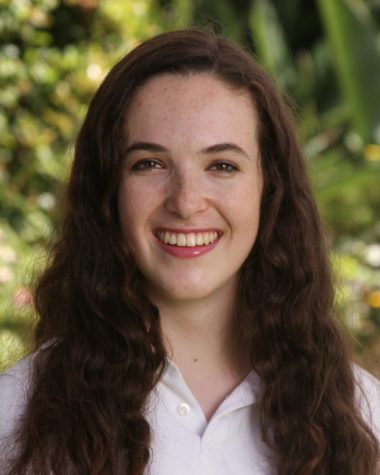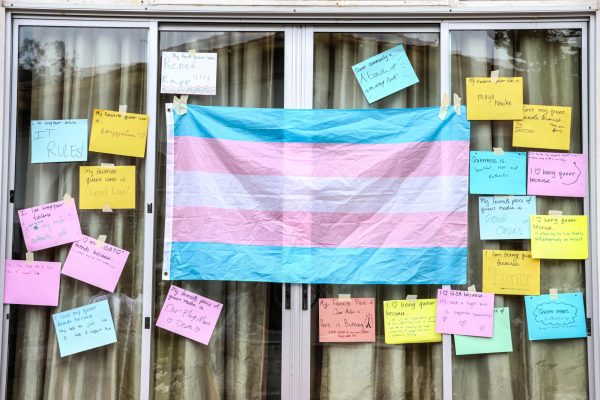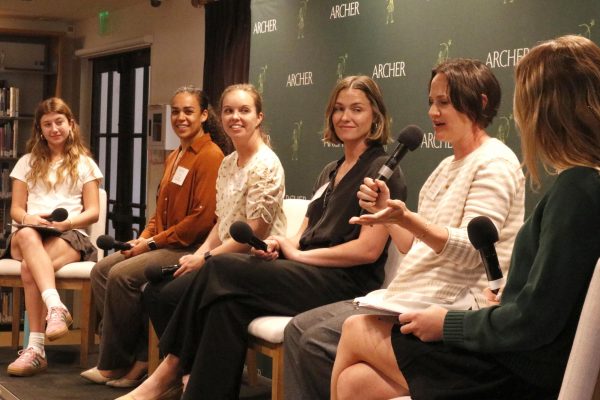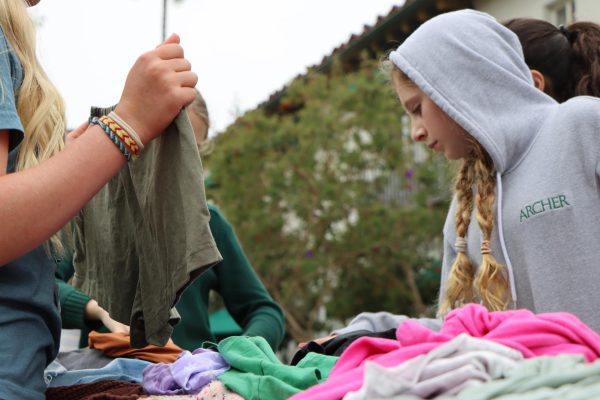Marine Yamada ’17 recognized for Lyme disease research
Marine Yamada ’17 poses with her finalized research poster at the 2016 Archer STEM Symposium. Yamada won a RISE (Research in Science and Engineering) Award at the conference and, having continued her research, has now been recognized by TakePart magazine and actor Ashton Kutcher. Photo courtesy of Yamada.
What do “The Real Housewives of Beverly Hills,” Lyme Disease and Ashton Kutcher have in common? They’ve all contributed to the growth of senior Marine Yamada’s scientific research.
Yamada began researching Lyme Disease detection as part of her Honors Research class in the 2015-2016 school year. She eventually presented her findings at the 2016 Archer STEM [Science, Technology, Engineering and Math] Symposium and won a RISE [Research in Science and Engineering] award, which granted her a thousand dollars to continue pursuing her studies.
“For my honors research project last year, I created the first point of care detector for Lyme disease, which is one of the hardest diseases to diagnose,” she said. “Currently, how Lyme is normally diagnosed is by a two-tier blood testing system, so you obviously need to go take blood and get it processed by a lab; it costs a lot of money and of course it also misdiagnoses up to 51 percent of patients. So, it’s just an inaccurate system that’s put in place right now.”
For her project, she created a “pee-stick,” similar to a pregnancy test, that detects bacteria from Lyme disease present in a patient’s urine. The eventual test would be at home and easily available.
Yamada cites the “Real Housewives of Beverly Hills” as the main source of inspiration for her research.
“I went through a bunch of project ideas, and one day, I was just really bored, and I decided to watch some ‘Real Housewives of Beverly Hills,’ as one does. I was expecting a little bit of trashy drama, like one of those episodes, but this one was actually about one of the main [stars], Yolanda Foster, who has Lyme disease and her struggle getting detected and treated,” she said.
“And I cried in that episode so many times. I thought, ‘This is a problem, let me see if I can find a solution to it.’ And that was basically my start.”
Her work has been recognized by TakePart magazine, as a stand-alone story and as a part of their global “16 in ’16” campaign, which, according to their website, aims to “take you inside the lives of 16 teenage girls today, and to show you their similarities and differences across borders, cultures, and social strata.”
Actor and celebrity Ashton Kutcher shared TakePart’s video on Facebook, leading to widespread attention to Yamada’s research. While she was flattered by the recognition, Yamada said the best part about it was hearing from people all around the country inspired by her story and eager to aid in her work.
“[Kutcher’s Facebook post] wasn’t the really, really cool part,” she said. “The part that was cool was that a lot of people from, like, Kentucky have been calling for me, and that’s been really interesting, because I actually do need urine samples. I love that the community beyond Archer knows about this now and wants to help this cause. I think it’s just great that Lyme disease in itself is getting a lot of attention because there needs to be a lot of studies done within the field anyway.”
Currently, Yamada is working on patenting her test and continuing to develop it. She’s excited about what her success might mean for Archer’s STEM program and for girls in the field in general.
She said, “I feel like, at Archer specifically, my project is getting a lot of attention just because our research program is relatively new — it hasn’t been around for 10, 20 years. So I think it’s exciting for me to just be one of the first of many people to do similar things and make discoveries that are really interesting and innovative.”
“I love that Archer is putting more strength in STEM because women are so underrepresented in those areas. I just hope that it can continue to grow, because science does cost a lot of money,” she continued. “Just buying my chemicals cost around 2,000 dollars, and if you want to get into the real gritty, detailed scientific work, then you need [expensive] machines, and I just hope that, if [schools] expect girls to make these sort of big scientific discoveries, then the funds are there to support that.”

Eloise Rollins-Fife joined the Oracle staff in 2015 and was promoted to co-Voices editor in 2016. She became the Managing/News & Features Editor for...







![Seniors laugh as they shoot water across the courtyard, during the annual fountain jump. I [the fountain jump] is really the culmination of your Archer experience, senior Ella Gray said. Especially because youre always around the fountain, at some point, and now you get to be in it.](https://archeroracle.org/wp-content/uploads/2024/05/MG_0817-1-600x400.jpg)





